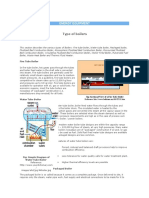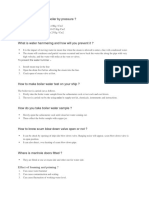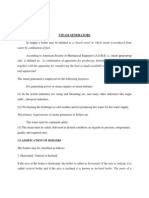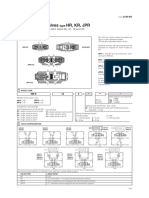Boiler Mountings and Accessories
Boiler Mountings and Accessories
Uploaded by
GokulAgCopyright:
Available Formats
Boiler Mountings and Accessories
Boiler Mountings and Accessories
Uploaded by
GokulAgOriginal Description:
Copyright
Available Formats
Share this document
Did you find this document useful?
Is this content inappropriate?
Copyright:
Available Formats
Boiler Mountings and Accessories
Boiler Mountings and Accessories
Uploaded by
GokulAgCopyright:
Available Formats
BOILER MOUNTINGS AND ACCESSORIES
Boiler Mountings. These are different fittings and devices which are necessary for the
operation and safety of a boiler. Usually these devices are mounted over boiler shell. In
accordance with the Indian boiler regulation the following mountings should be fitted to the
boilers
Two safety valves
Two water level indicators
A pressure gauge
A steam stop valve
A feed check valve
A blow-off cock ;1
.An attachment for inspectors test gauge
A man hole
Mud holes or sight holes.
Boilers of Lancashire and Cornish type should be fitted with a high pressure and low
water safety valve
All land boilers should have a fusible plug in each furnace.
Boiler Accessories. These are auxiliary plants required for steam boilers for their
proper operation and for the increase of their efficiency. Commonly used boiler accessories are
Feed pumps
Injector
Economiser
Air preheater
Superheater
Steam separator
Steam trap.
BOILER MOUNTINGS
The various boiler mountings are discussed as follows
Water Level Indicator
The function of a water level indicator is to indicate, the level of water in the boiler
con8tdntly. It is also called water gauge. Normally two water level indicators are fitted at the
front end of every boiler. Where the boiler drum is situated at considerable height from the floor,
the water gauge is often inclined to make the water level visible from any position. When the
water being boated in the boiler transforms into steam the level of water in the boiler shell goes
on decreasing. For the proper working of the boiler, the water must be kept at safe-level. If the
water level falls below the safe level and the boiler goes on producing steam without the addition
of feed water, great damage like crack and leak can occur to the parts of the boiler which get
uncovered from water. This can result in the stoppage of steam generation and boiler operation.
Figure shows a Hopkinsons water gauge. It is a common form of glass tube water-level
gauge. A is the front end plate of the boiler. F is a very hard glass tube indicating water level and
is connected to the boiler plate through stuffing boxes in hollow gun metal castings (B, C) having
flanges X, Y for bolting the plate.
For controlling the passage of steam and water cocks D and E are provided. When
these cocks are opened the water stands in the glass tube at the same level as in the boiler. K is
the drain cock to blow out water at intervals so as not to allow any sediments to accumulate.
Upper and lower stuffing boxes are connected by a hollow metal column G. Balls J and H rest in
the position shown in the normal working of the gauge. When the glass tube breaks due to rush
of water in the bottom passage the balls move to dotted positions and shut off the water and
steam. Then the cocks D and E can be safely closed and broken glass tube replaced. M, N, P and
.R are screwed caps for internal cleaning of the passage after dismantling. L is the guard glass ; it
is tough and does not give splinters on breaking. Thus when the gauge glass breaks, and this
guard glass which normally will hold flying pieces, also gives way, the pieces will not fly one
and hurt the attendant.
Pressure Gauge
The function of a pressure gauge is to measure the pressure exerted inside the vessel. The
gauge is usually mounted on the front top of the shell or the drum. It is usually constructed to
indicate upto double the maximum working pressure. Its dial is graduated to read pressures in
kgcm2 (or bar) gauge (i.e., above atmospheric). There are two types of pressure gauges: (i)
Bourdon tube pressure gauge and (ii) Diaphragm type pressure gauge. A pointer, which rotates
over a circular graduated scale, indicates the pressure.
A pressure gauge is known as compound pressure gauge if it is designed in such a
fashion so as to measure pressures above and below the atmosphere on the same dial.
Figure shows a Bourdon pressure gauge (single tube) a common type of pressure gauge
used. The essential feature of this gauge is the elliptical spring tube which is made of a special
quality of bronze and is solid drawn. One end A is closed by a plug and the other is connected
with a block C, the block is connected with a syphon tube (which is full of condensed water).
The steam pressure forces the water from the syphon tube into elliptical tube and this causes the
tube to become circular is cross-section. As the tube is fixed at C, the other end A moves
outwards. This outward movement is magnified by the rod R and transmitted to toothed sector T.
This toothed sector is hinged at the point H and meshes with the pinion P fixed to the spindle of
the pointer N. Thus the pointer moves and registers the pressure on a graduated dial.
The movement of the free end of the elliptical tube is proportional to the difference
between external and internal pressure on the tube. Since the outside pressure on the tube is
atmospheric, the movement of the free end is a measure of the boiler pressur above atmospheric
i.e., gauge pressure.
Figure shows a U-tube syphon which connects the gauge to the boiler. The U-tube
syphon is connected to the steam space of the boiler and contains condensed steam which enters
the gauge tube. The condensed water transmits pressure to the gauge, and at the sametime
prevents steam from entering the pressure gauge. In case steam passes into the gauge tube it will
expand the tube and reading obtained will be false. Furthermore metal may be affected. Plug R is
used for connecting the inspectors standard gauge and testing accuracy of boiler pressure gauge
while in service. Plug Z is employed for cleaning the syphon. Three way cock S is used for either
connecting the boiler pressure gauge to steam space or inspectors pressure gauge to the steam
space. The double-tube Bourdon gauge is more rigid than the single tube and more suitable for
locomotive
and portable boilers.
Safety Valves
The function of a safety valve is to release the excess steam when the pressure of steam
inside the boiler exceeds the rated pressure. As soon as the pressure of steam inside the boiler
exceeds the rated pressure the safety valve automatically opens and excess steam rushes out into
the atmosphere till the pressure drops down to the normal value. A safety valve is generally
mounted on the top of the shell.
As per boiler regulations every boiler must be fitted at least with two safety valves.
The various types of safety valves are enumerated and discussed as follows:
1. Dead weight safety valve.
2. Lever safety valve.
3. Spring loaded safety valve.
4. High steam and low water safety valve.
Dead Weight Safety Valve
Figure shows a dead weight safety valve. A is the vertical cast iron pipe through which
steam pressure acts. B is the bottom flange directly connected to seating block on the boiler shell
communicating to the steam space. V is the gun metal valve and VS is the gun metal valve seat.
D is another cast iron pipe for discharge of excess steam from the boiler. W are the weights in the
form of cylindrical disc of cast iron. WC is the weight carrier carrying the weights W. The cover
plate C covers these weights. The steam pressure acts in the upward direction and is balanced by
the force of the dead weights W. The total dead-weights consist of the sum of the weights W,
weight of the valve V, weight of the weight carrier and weight of the cover plate C.
When the steam pressure is greater than the working pressure it lifts the valve with its
weights. So the steam escapes from the boiler and the steam pressure thereby decreases.
Merits of dead weight safety valve
1. Simplicity of design.
2. Gives quite a satisfactory performance during operation.
3. It cannot be easily tempered from the pressure adjustment view-point.
Demerits:
1. Unsuitable for use on any boiler where extensive vibration and movement are experienced
(e.g. locomotive and marine work).
2. It is not suitable for high pressure boilers because a large amount of weight is required to
balance the steam pressure.
Uses. It is mainly used for low pressures, low capacity, stationary boilers of the Cornish and
Lancashire types.
Lever Safety Valve
It consists of a lever and weight W. The valve (r1ade of gun metal) rests on the valve seat
(gun metal) which is screwed into the valve body ; the valve seat can be replaced if required. The
valve body is fitted on the boiler shell. One end of the lever is hinged while at the other is
suspended a weight W. The strut presses against the valve on seat against the steam pressure
below the valve. The slotted lever guide allows vertical movement to the lever.
When the steam pressure becomes greater than the normal working pressure, the valve is
lifted with the lever and the weight. Consequently, the steam escapes through the passages
between the valve and seat and the steam pressure decreases. The disadvantages of this valve is
that it admits of being tempered with, and the effect of a small addition to the weight is magnified
considerably in its action on the valve. Figure shows the loading arrangement on the lever
Economiser
An economiser is a device in which the waste heat of the flue gases is utilised for heating
the feed water.
Economiser are of the two types (i) Independent type, and (ii) Integral type. Former is
installed in chamber apart from the boiler setting. The chamber is situated at the passage of the
flow of the flue gases from the boiler or boiler to the chimney. Latter is a part of the boiler
heating surface and is installed within the boiler setting.
Figure shows an independent type vertical tube economiser (called Greens economiser).
It is employed for boilers of medium pressure range upto about 25 bar. It consists of a large
number of vertical cast iron pipes P which are connected with two horizontal pipes, one at the
top and the other at the bottom. A is the bottom pipe through which the feed water is pumped into
the economiser. The water comes into the top pipe B from the bottom pipe (via vertical pipes)
and finally flows to the boiler, The flue gases move around the pipes in the direction opposite to
the flow of water. Consequently, heat transfer through the surfaces of the pipes takes place and
water is thereby heated. A blow-off cock is provided at the back end of vertical pipes to remove
sediments deposited in the bottom boxes. The soot of the flue gases which gets deposited on the
pipes reduces the efficiency of the economiser. To prevent the soot deposit, the scrapers S move
up and down to keep the external surface of the pipe clean (for better heat transfer). By-pass
arrangement enables to isolate or include the economiser in the path of flue gases.
The use of an economiser entails the following advantages
1. The temperature range between various parts of the boiler is reduced which results in
reduction of stresses due to unequal expansion.
2. If the boiler is fed with cold water it may result in chilling the boiler metal. Hot feed water
checks it.
3. Evaporative capacity of the boiler is increased.
4. Overall efficiency of the plant is increased.
Air Preheater
The function of the air pre-heater is to increase the temperature of air before it enters the
furnace. It is generally placed after the economiser ; so the flue gases pass through the
economiser and then to the air preheater. An air-preheater consists of plates or tubes with hot
gases on one side and air on the other. It preheats the air to be supplied to the furnace. Preheated
air accelerates the combustion and facilitates the burning of coal.
Degree of preheating depends on
Type of fuel,
(iii) Rating at which the boiler and furnace are operated.
There are three types of air preheaters
1. Tubular type
2. Plate type
3. Storage type.
Figure shows a tubular type air preheater. After leaving the boiler or economiser the
gaseous products of combustion travel through the inside of the tubes of air preheater in a
direction opposite to that of air travel and transfer some of their heat to the air to be supplied to
the furnace. Thus the air gets initially heated before being supplied to the furnace. The gases
reverse their direction near the bottom of the air heater, and a soot hopper is fitted to the bottom
of air heater casing to collect soot.
In the plate type air preheater the air absorbs heat from the hot gases being swept
through the heater at high velocity on the opposite side of a plate. Figure shows a self
explanatory sketch of a storage type air preheater (heat exchanger).
Finally the gases escape to the atmosphere through the stack (chimney). The temperature
of the gases leaving the stack should be kept as low as possible so that there is minimum loss of
heat to the stack. Storage type air preheaters are employed widely in larger plants.\
You might also like
- Infomation Wds Flow Controls TaiwanDocument8 pagesInfomation Wds Flow Controls TaiwanjuanrosonNo ratings yet
- 883 MKII Illustrated Parts Catalog Revision 2Document311 pages883 MKII Illustrated Parts Catalog Revision 2Herdre Van Niekerk100% (1)
- The 2 Stroke Diesel CycleDocument14 pagesThe 2 Stroke Diesel CycleBharatiyulam100% (1)
- Regenerator & RecuperatorDocument33 pagesRegenerator & RecuperatorDhrubajyoti Das100% (1)
- Comparison Astm and JisDocument4 pagesComparison Astm and JisGokulAgNo ratings yet
- Boiler MountingsDocument15 pagesBoiler MountingsBishwajit MahatoNo ratings yet
- Boiler MountingsDocument11 pagesBoiler MountingsVikash MehtaNo ratings yet
- Boiler Mountings and Accessories1Document31 pagesBoiler Mountings and Accessories1anuranjanshardaNo ratings yet
- Boiler Mountings and AccessoriesDocument14 pagesBoiler Mountings and AccessoriesAnil DamaheNo ratings yet
- Boiler Mountings and AccessoriesDocument33 pagesBoiler Mountings and AccessoriesSiddhant Singh100% (1)
- The Dead Weight Safety Valve Consists of A ValveDocument4 pagesThe Dead Weight Safety Valve Consists of A ValveAsif Saleem0% (1)
- Shaping MachineDocument14 pagesShaping MachineMohammad Javed IqbalNo ratings yet
- Boiler Safety ValveDocument12 pagesBoiler Safety ValveJaroslav Kuruc100% (3)
- Ic Engine Lab ManualDocument24 pagesIc Engine Lab ManualBanwari Lal Prajapat100% (1)
- Schmidt Hartmann Boiler 1Document24 pagesSchmidt Hartmann Boiler 1Varun KarriNo ratings yet
- Stirling BoilerDocument14 pagesStirling BoilerDr. BIBIN CHIDAMBARANATHANNo ratings yet
- Boiler Mounting & AccessoriesDocument14 pagesBoiler Mounting & Accessoriesshiraj36100% (1)
- Boiler With Mountings and AccessoriesDocument67 pagesBoiler With Mountings and AccessoriesYashvir Singh100% (2)
- me8361-MT 1 LabmanualDocument37 pagesme8361-MT 1 LabmanualHOD ITNo ratings yet
- Fresh Water GeneratorDocument2 pagesFresh Water GeneratorMylene CamachoNo ratings yet
- What Is A Boiler? What Are Parts of A Boiler?Document24 pagesWhat Is A Boiler? What Are Parts of A Boiler?dharanistrikezNo ratings yet
- Simple Vertical BoilerDocument11 pagesSimple Vertical BoilerPardeep8056No ratings yet
- Introduction: Marine Boiler Safety ValvesDocument2 pagesIntroduction: Marine Boiler Safety ValvesSahil MishraNo ratings yet
- Cornish BoilerDocument2 pagesCornish Boileranmolkasera100% (1)
- Exp No 04 Working of High Pressure Boiler.Document6 pagesExp No 04 Working of High Pressure Boiler.Aasawari Mahagaonkar100% (1)
- Thermodynamic CyclesDocument9 pagesThermodynamic CyclesPilar Guzmán MartínezNo ratings yet
- Instrument & Service AirDocument2 pagesInstrument & Service AirIgn AgungNo ratings yet
- Benson BoilerDocument21 pagesBenson BoilerDr. BIBIN CHIDAMBARANATHANNo ratings yet
- 4 Point Starter - Working Principle and Construction of Four Point StarterDocument3 pages4 Point Starter - Working Principle and Construction of Four Point StarterMohd Rashid SiddiquiNo ratings yet
- Boiler:: Working Principle of A BoilerDocument22 pagesBoiler:: Working Principle of A BoilerZeshan AbdullahNo ratings yet
- Heat Engine-GTU-Sem-1Document78 pagesHeat Engine-GTU-Sem-1Khushank MNo ratings yet
- 2013edusat Lecture On STEAM PLANTDocument101 pages2013edusat Lecture On STEAM PLANTKishore KrishnaNo ratings yet
- Phase II Boiler QuestionsDocument12 pagesPhase II Boiler QuestionsNithin Varghese100% (1)
- Babcock and Wilcox Boiler - Construction, Working, Application, Advantages and Disadvantages - Mechanical BoosterDocument7 pagesBabcock and Wilcox Boiler - Construction, Working, Application, Advantages and Disadvantages - Mechanical BoosterSaketh Vaishya100% (1)
- Condenser & BoilerDocument33 pagesCondenser & BoilerShaun Patrick Albao100% (2)
- Type of BoilersDocument5 pagesType of Boilersnagraj204No ratings yet
- Automobile Engineering Lab ExperimentDocument7 pagesAutomobile Engineering Lab ExperimentNidhi BharatiyaNo ratings yet
- For BoilerDocument71 pagesFor BoilerSonal PotdarNo ratings yet
- Chapter 1: Boilers and ComponentsDocument12 pagesChapter 1: Boilers and ComponentseugeneNo ratings yet
- BoilersDocument67 pagesBoilerssahilchemNo ratings yet
- Cochran Boiler: It Consists ofDocument4 pagesCochran Boiler: It Consists ofIndra Kumar TrivediNo ratings yet
- Water Circulation SystemDocument16 pagesWater Circulation SystemAkashKishoreNo ratings yet
- To Study The Model of Lancashire and Babcock & Wilcox BoilerDocument5 pagesTo Study The Model of Lancashire and Babcock & Wilcox BoilerDr. AITH Kanpur100% (1)
- Metering DevicesDocument8 pagesMetering DevicesKudzai ManyanyeNo ratings yet
- Lab Report 4.Document7 pagesLab Report 4.Usman Ali Usman AliNo ratings yet
- Chapter 4 - Steam Generators (Boilers)Document55 pagesChapter 4 - Steam Generators (Boilers)rrhoshackNo ratings yet
- Velox BoilerDocument16 pagesVelox BoilerDr. BIBIN CHIDAMBARANATHAN100% (1)
- Types of Exhaust Gas Boiler (EGB) Fires and Ways To Prevent ThemDocument4 pagesTypes of Exhaust Gas Boiler (EGB) Fires and Ways To Prevent ThemGiorgi KandelakiNo ratings yet
- Boiler Q&A FurtherDocument7 pagesBoiler Q&A FurtherRachitNo ratings yet
- Chapter 1 Properties of SteamDocument40 pagesChapter 1 Properties of SteamPrateek ridersNo ratings yet
- Thermal Power Plant - Diagram, Layout, Working & ConstructionDocument25 pagesThermal Power Plant - Diagram, Layout, Working & ConstructionACME NKSTPPNo ratings yet
- Unit V Steam Generator or BoilerDocument127 pagesUnit V Steam Generator or BoilerHarsh Pratap SinghNo ratings yet
- Cochran BoilerDocument5 pagesCochran Boilerpankaj chaudharyNo ratings yet
- Study of Steam TurbineDocument3 pagesStudy of Steam TurbineJohn Fredy100% (2)
- Steam Boilers ME 1103 Introduction To MeDocument27 pagesSteam Boilers ME 1103 Introduction To MePriyadarshee ShaswatNo ratings yet
- Loeffler BoilerDocument22 pagesLoeffler BoilerDr. BIBIN CHIDAMBARANATHAN0% (1)
- Why Air Vent Should Be Closed Maintaining 2kg/cm 2 Drum Level Pressure at Starting of Boiler Operation?Document2 pagesWhy Air Vent Should Be Closed Maintaining 2kg/cm 2 Drum Level Pressure at Starting of Boiler Operation?Ashish KapoorNo ratings yet
- Expansion DevicesDocument13 pagesExpansion DevicesManik SinghNo ratings yet
- Fossil Fuel Steam GeneratorDocument33 pagesFossil Fuel Steam Generatorchaiya sonwongNo ratings yet
- Practical Boiler Operation EngineeringDocument55 pagesPractical Boiler Operation EngineeringDaniel GómezNo ratings yet
- Automobile Engineering Lab II (ETPM Lab)Document4 pagesAutomobile Engineering Lab II (ETPM Lab)Souvik BanerjeeNo ratings yet
- Chapter 5Document32 pagesChapter 5fahadwaliantNo ratings yet
- Boiler MountingsDocument40 pagesBoiler Mountingspavansvgp2003No ratings yet
- Centrifugal CompressorsDocument6 pagesCentrifugal CompressorsGokulAgNo ratings yet
- Reaction TurbineDocument10 pagesReaction TurbineGokulAgNo ratings yet
- Steam NozzlesDocument24 pagesSteam NozzlesGokulAgNo ratings yet
- Steam Generators-Fire Tube BoilersDocument11 pagesSteam Generators-Fire Tube BoilersGokulAgNo ratings yet
- Thermal Engineering (MG UNIVERSITY) PART1Document26 pagesThermal Engineering (MG UNIVERSITY) PART1GokulAgNo ratings yet
- EPV16Document100 pagesEPV16hrmlynNo ratings yet
- Definox Control TopDocument4 pagesDefinox Control Topfendi_3606No ratings yet
- R165 PDFDocument204 pagesR165 PDFred100% (1)
- Above-Ground Petroleum Storage Tank Manual With Data On NC Gasoline Vapor Recovery & EPA Spill Plan InformationDocument25 pagesAbove-Ground Petroleum Storage Tank Manual With Data On NC Gasoline Vapor Recovery & EPA Spill Plan Informationck19654840No ratings yet
- Seal Weld Activ 8Document23 pagesSeal Weld Activ 8Mostafa NabilNo ratings yet
- VIN Solenoid Valve DSL103seriesDocument14 pagesVIN Solenoid Valve DSL103seriesAndres Cardenas MoyaNo ratings yet
- Methodology Tapping Methodology of WaterlineDocument15 pagesMethodology Tapping Methodology of WaterlineBryNo ratings yet
- ATI Brochure Web 2015 07 02 PDFDocument12 pagesATI Brochure Web 2015 07 02 PDFabdelkader benabdallahNo ratings yet
- SI573.08r1en - VLBN - Part40Document1 pageSI573.08r1en - VLBN - Part40AhmadNo ratings yet
- 007 - CAT-6040 - RH170B - Logic ControlDocument18 pages007 - CAT-6040 - RH170B - Logic ControlJorby CuadrosNo ratings yet
- VR RLBVR RL HBFF ENDocument33 pagesVR RLBVR RL HBFF ENSushil Meshram100% (1)
- Types 1098-EGR and 1098H-EGR Pressure Reducing RegulatorsDocument24 pagesTypes 1098-EGR and 1098H-EGR Pressure Reducing RegulatorsFRANCISCONo ratings yet
- EPRI PaperDocument14 pagesEPRI Paperemperor_vamsiNo ratings yet
- Mock Drill Report On IA Failure Dated 09.04.2023Document6 pagesMock Drill Report On IA Failure Dated 09.04.202300083583rfNo ratings yet
- Steam Tracing StudyDocument4 pagesSteam Tracing StudypalluraviNo ratings yet
- Pressure Regulating Valve Valvulas by Pass Catalogo EquigasDocument1 pagePressure Regulating Valve Valvulas by Pass Catalogo EquigasecsuperalNo ratings yet
- Maintenance Manual Engine XinchaiDocument14 pagesMaintenance Manual Engine XinchaiМаксимNo ratings yet
- Sprinkler MethodDocument6 pagesSprinkler Methodakram husseinNo ratings yet
- KSP CatalogueDocument9 pagesKSP CatalogueDeep YadavNo ratings yet
- D180Document4 pagesD180Aan TeeNo ratings yet
- Case 430 FuelDocument8 pagesCase 430 FuelKot878No ratings yet
- PEP-FGS-SAL-INST-DS-012 - Pressure Switch Datasheet Rev A - Comment PEPDocument16 pagesPEP-FGS-SAL-INST-DS-012 - Pressure Switch Datasheet Rev A - Comment PEPabraryusra205No ratings yet
- EAMII0001 Axial Flow Valves 9710 7 032713ADocument30 pagesEAMII0001 Axial Flow Valves 9710 7 032713AMisael Cardenas BarriosNo ratings yet
- 2p FPSDocument46 pages2p FPSamitNo ratings yet
- AccuStream 13903 AccuValve Configuration SheetDocument1 pageAccuStream 13903 AccuValve Configuration SheetAdelaNo ratings yet
- Emergency Fire Pump FFV-100DDocument12 pagesEmergency Fire Pump FFV-100DsuranovoleksandrNo ratings yet
- Bom 20190524Document1 pageBom 20190524Giang Nguyễn TrườngNo ratings yet
- ENSC3003 - Fluid Mechanics Lab 3 Pumps: Student NameDocument14 pagesENSC3003 - Fluid Mechanics Lab 3 Pumps: Student Namedist2235No ratings yet































































































